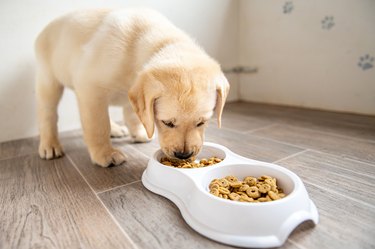If your dog has kidney disease, making a renal dog food recipe at home may be the trick to encourage your sick pup to eat. Since one of the main functions of the kidney is to filter toxins, if your dog's kidneys aren't functioning properly, toxins can build up in the bloodstream, leaving your dog nauseous and unwilling to eat. Don't start feeding just any tasty treat, though. There are many things to consider when making homemade dog food to ensure your dog gets the nutrients he needs.
Transition to a kidney diet
Video of the Day

There are several considerations when calculating the nutrients your dog will need on a kidney diet. This will vary depending on the severity of the kidney disease and any other conditions your dog may have, such as food allergies or pancreatitis. While there are commercial foods to consider, such as Hill's Prescription Diet k/d kidney care dog food, some dogs will turn their nose up at these prescription foods.
Video of the Day
Cooking homemade dog food for kidney disease is a great way to encourage your dog to eat and stay healthy, but ensuring they get the proper nutrients can be a challenge, especially with the restrictions that come with a kidney diet.
Be sure to only follow a renal dog food recipe that is approved by your veterinarian and be sure to follow the recipe exactly. You can find recipes at BalanceIT.com, a site that is supported by board-certified veterinarians. They have recipes for many conditions, including kidney disease, and make recommendations for recipes and supplements. You will need to request access by entering your veterinarian's information and getting approval to access the recipes.
Renal diet nutritional restrictions
When making home-cooked dog food for kidney disease, there are several things you will need to consider to ensure your dog is getting the right amount of certain nutrients. One of the main considerations when planning a kidney diet is ensuring that it is low in phosphorous. Since the kidneys aren't able to filter out the phosphorous, it can build up in the bloodstream and cause the disease to progress faster. Too much phosphorous can also lead to bone loss as it triggers the release of the parathyroid hormone that causes the body to remove calcium and phosphorous from the bones.
Your veterinarian will also likely recommend a lower protein diet. While high protein itself doesn't cause further damage to the kidneys, the digestion of protein can cause nitrogen to build up in the body. Additionally, most meats are high in phosphorous.

Sodium plays a critical role in maintaining proper water balance and blood pressure. Your veterinarian will likely recommend lowering the amount of sodium in your dog's daily diet as kidney function decreases. Potassium is another consideration when planning your dog's diet. Dogs with kidney disease vary in the amount of potassium they have in their bloodstream, but in general, they will have hyperkalemia, or too much potassium. Your vet will make specific recommendations for your dog's needs and stage of kidney failure.
Treats and other considerations
While you need to limit some nutrients, supplementing others can be beneficial. B vitamins, for example, play an important role in the body's metabolic processes and they are water-soluble, which means they aren't stored in the body. Most commercial kidney diet dog foods have added B vitamins and your veterinarian may recommend adding a supplement to your dog's homecooked diet.
Although the research isn't conclusive, many studies have shown that giving supplemental omega-3 fatty acids, which are found in fish oil, may have a protective effect on the kidneys. Additionally, adding liquid fish oil may make the meal more appetizing for your dog.

A kidney diet doesn't necessarily mean you have to give up treats, but you will need to switch to another option. If you opt to purchase a commercial treat, be sure to check the nutrition label and select an option that has less than 150 milligrams of phosphorus and 100 milligrams of sodium for every 100 calories. You can also consider some low phosphorous fruits and vegetables such as broccoli, watermelon, apples, carrots, and green beans. Remember that treats should make up no more than 10 percent of your dog's daily calorie intake and be sure to discuss your dog's specific needs with your veterinarian.
- Balance IT: Homemade Food
- American Kennel Club: Cooking For Your Dog: Do’s & Don’ts of Homemade Dog Food
- DMV360: Renal Diets for Veterinary Patients: What To Feed and When To Start
- American Kennel Club: Kidney Disease in Dogs: How Much Do You Know?
- Cummings Veterinary Medical Center at Tufts University: What Treats Can I Give My Dog With Kidney Disease?